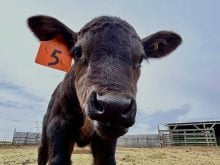Both beginning and established farmers face many hurdles when purchasing cattle, with the most prominent often a lack of available investment capital.
To address this issue, many provinces operate co-operatives for both fed cattle and breeding stock. In Alberta for example, a feeder co-operative is made up of a group of producers who have combined resources with the Alberta government and lending institutions to provide a cost-effective means of financing that may not be available to individual producers.
“The co-operative approach has long been part of the lifeblood of Alberta’s beef industry,” says Reg Schmidt, Zone 3 director of the Feeder Associations of Alberta. “Throughout our 85-year history, their importance has been deep seated and they continue with an ongoing relevance today.”
Read Also

Harvest wraps up and fall work begins
At the Eppich famly ranch in western Saskatchewan, the fall harvest was successful with few breakdowns, cows and calves have been sorted and a new tractor has arrived
FACTS AND STATS
In November 2022, the Alberta government increased the feeder association guarantee by 50 per cent, raising it from $100 to $150 million, largely to help offset increasing cattle prices.
Schmidt says their feeder associations currently finance over 22 per cent of all feeder cattle in the province and support more than 3,500 members. Up to $2 million of capital is available per farm entity, with only a five per cent security deposit. Breeder co-operatives require a 10 per cent deposit on purchases up to $500,000, much less than traditional banks and lending institutions demand.
“The programs offer all levels of farmers access to capital they otherwise wouldn’t be able to get,” Schmidt says. “It helps build long-term industry sustainability.”
Further west, Lindy Gilson, administrator for the B.C. Breeder and Feeder Associations, says the combination of their programs is especially beneficial for young beginning farmers growing their herds.
READ MORE: U.S. livestock: feeder cattle futures gain boost from corn market weakness
Their unique interest-relief component provides a substantial savings on feeder cattle, which helps deliver spinoff benefits as cows and heifers become transferable into five-year breeding plans. Members can use the feeder option to purchase replacement heifers for later retention, making it simpler to expand a cow herd.
LOYALTY AND COMFORT DRIVE BUSINESS
Schmidt says the relationships between Alberta’s 45 co-operatives are complicated with a mix of competitiveness and member comfort. The co-operatives tend to work together for the betterment of all, due to identical provincial operating regulations, but they are still competitive. Each association has variable fees for example, as each controls their own costs and charges.
“Producers are extremely loyal with their local co-operatives, even if they’re not physically the closest,” says Schmidt. “They want stability, and not only with capital. If they come across a hot feeder cattle sale in September, they want to be confident they can get a P.O. with only a phone call. That comfort makes it work.”
While the programs offer attractive five and 10 per cent deposits which tie up fewer farm finances and additional equity, longer-term benefits are harder to quantify. Since many co-operatives have been running for decades, their community-based focus and economic spinoffs help drive long-term growth and stability.
FLEXIBILITY AND FUTURE CHANGES
Gilson suggests the flexibility of B.C.’s associations is key for their members, providing many opportunities for regional growth.
“The Advance Payments Program, for example, allows our members to receive an cash advance on calves, then make their bred cattle payments, with the balance of proceeds theirs to use as they please. It’s similar to a summer operating loan.”
READ MORE: Understanding the feeder cattle market
The number of Alberta’s associations has dropped from 70 to 45 in the last 20 years due to consolidation, but many smaller groups continue to maintain relatively issue-free operations while supporting their local economies.
“Generally, the larger associations tend to be more successful, having three to four full-time staff focused on managing the loans and membership,” Schmidt says. “In the smallest groups the administrator is often working off the kitchen table as well as a being the supervisor checking cattle between farm tasks.” It may not be an ideal situation, but it works.
He believes change in the industry happens largely due to its own momentum. Trying to force major changes such as consolidation of smaller co-operatives is like trying to push a string uphill. Members have an established loyalty and comfort to their association, so changes need to happen of their own volition.
For Gilson, an increase in individual finance limits would be the most prominent change B.C. co-operatives would desire. She adds this aspect is already in the works and should build on their currently successful feeder and breeder programs.
Schmidt says co-operatives will continue to be a force to be reckoned with. Although Alberta’s representatives are the largest, they associate interprovincially, meeting once a year with provincial counterparts to share notes, discuss strengths and weaknesses along with improvement ideas.
“I would say both the feeder and breeder co-ops are here to stay,” says Schmidt. “They’re an integral part of our industry and producers are finding them useful and comfortable in their operations,” he says.















